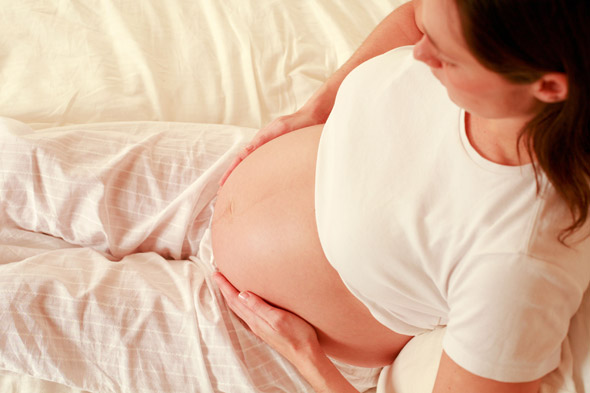When you are expecting a baby, the thought of labor starting is always exciting – it means that you will soon meet your new bundle of joy! But sometimes contractions aren't as clear-cut as the movies make them seem. Braxton Hicks contractions are "practice" contractions that prepare your body for the "real" thing. However, these practice contractions can definitely feel real, especially as you approach your due date. When you feel Braxton Hicks at 35 weeks or later, how can you tell if they are "practicing" or the real thing?
Braxton Hicks at 35 Weeks: What Does It Feels Like?
Braxton Hicks can begin earlier in the pregnancy, but get stronger as the weeks go on. They usually start as very mild contractions, more like a tightening of the uterus that makes your abdomen very hard and tight. They will show up and stay for up to 30 seconds, and then they will slowly dissipate. Some women don't feel any pain with them at all.

Braxton Hicks contractions work to tone the uterus, but they don't resulting in dilating the cervix, which is why they aren't considered as true labor. But how can you tell, especially if the Braxton Hicks hurt? Here are a few ways to differentiate between Braxton Hicks contractions and true labor contractions:
- Braxton Hicks are usually along the front of your uterus. Real contractions will often start at the top and move down, and might wrap around to your back. As they get stronger, your whole body feels involved.
- The intensity of Braxton Hicks remains the same, but true labor contractions continue to get worse, no matter what you do.
- If you change your activity or position, or even drink some cold water, the Braxton Hicks contractions will ease. Real contractions will continue to get worse, and those changes might actually make them stronger.
- Braxton Hicks can come on without warning, and they are rarely consistent. True contractions will keep coming at regular intervals, and will gradually get closer together.
- Braxton Hicks contractions are often so light that you can easily talk and breathe through them. True labor contractions can take your breath away and make it very difficult to speak or even think during the height of the pain.
The video below tells you more about these two kinds of contractions:
Braxton Hicks at 35 Weeks: How to Ease the Discomfort
Many women will find that Braxton Hicks at this period are really unpleasant, and for some,they can really hurt! And it seems like almost anything can trigger them, including not drinking enough, having sex with your partner, having a full bladder, eating a meal, walking around your house, or someone simply rubbing your belly.
If you are dealing with Braxton Hicks at 35 weeks that seem quite strong, you can find some relief with these ideas:
- Sink into a warm bath and relax with a good book. Often the relaxation and the distraction can make them ease.
- Change your activity. The more you move with Braxton Hicks, the less likely they are to continue.
- Change up your position – if you are sitting down, stand up. If you are lying down, sit up. A change in position will often banish the contractions altogether.
- Go with slow, deep breathing, just as if you were in true labor. This can help you deal with the discomfort, as well as giving you a chance to practice the breathing technique for labor.
- Drink plenty of water if the Braxton Hicks keep coming, because you might be dehydrated. Not having enough liquid in your body is one of the reasons why Braxton Hicks show up.
Braxton Hicks at 35 Weeks: When Should You Seek Medical Help?
You'd better get in touch with your doctor if you are having any of the following signs.
- You experience more than four contractions in one hour.
- You begin bleeding or spotting, or notice a change in discharge from your vagina.
- You notice mucus leaked with blood when you go to the bathroom.
- You are experiencing intense pressure in your pelvic area.
- You have lower back pain, abdominal cramping, or pain in your lower abdomen that feels like menstrual cramps.
Moms' Experiences of Braxton Hicks at 35 Weeks
Here are some examples of real-world experiences:
"I started having Braxton Hicks that were really painful. I drank plenty of water but that didn't seem to help. For some reason, lying down on my left side immediately made them stop. Now I know that lying down is the key for me to make them go away."
"When the Braxton Hicks become too much, I get into a warm shower. I also use some aromatherapy body wash. I think the relaxation helps."
"If you are having these all the time, it might be a sign that it's time to slow down. I had them over and over until I went on maternity leave, and after I was able to sit down at home for days with my feet up, they went away. I didn't have another contraction until real labor began."
"Imagine that someone is wrapping a sheet around your belly and pulling it very tight. That's what they feel like of Braxton hicks at 35 weeks for me. It's interesting, especially because they usually don't hurt!"
"I learned that if I were worried about the real thing, I just need to take a nap. However, I will be able to sleep through Braxton Hicks, but there is absolutely no way I can sleep through real labor without the benefit of serious pain meds!"
